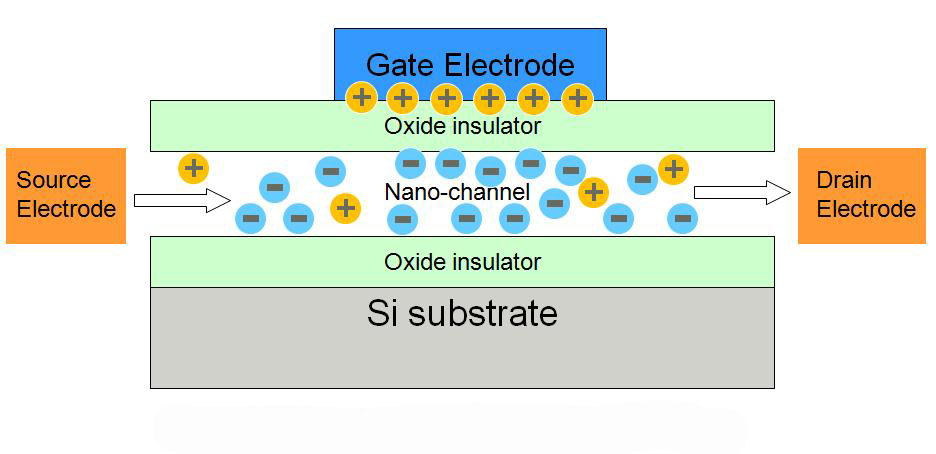Nanofluidic Transistors: Controlling Fluids at the Nanoscale
What are Nanofluidic Transistors?
Nanofluidic transistors, also known as nanofluidic systems or nanofluidic devices, are innovative tools that control the flow of fluids, such as water or ions, through nanoscale channels using electric fields. These devices operate on principles similar to electronic transistors, but instead of regulating the flow of electrons, they manipulate the movement of fluids at the nanoscale. Nanofluidic transistors have emerged as powerful tools for precise control and manipulation of fluids in various applications, including biosensing, drug delivery, and molecular separation.

Key Components of Nanofluidic Transistors
Nanofluidic transistors consist of three main components:
- Nanoscale Channel: The heart of a nanofluidic transistor is a nanoscale channel through which fluids flow. These channels are typically fabricated using advanced nanofabrication techniques, such as electron beam lithography or focused ion beam milling. The dimensions of the nanochannels range from a few nanometers to several hundred nanometers, enabling precise control over fluid transport in these nanofluidic systems.
- Gate Electrode: The gate electrode is a crucial component of a nanofluidic transistor. It is positioned near the nanochannel and is used to apply an electric field that modulates the flow of fluids through the channel. By varying the gate voltage, the electric field can be adjusted to control the flow rate, direction, and selectivity of the fluid transport, often through electroosmotic flow.
- Source and Drain: The source and drain are the inlet and outlet of the nanofluidic transistor, respectively. They are connected to the nanochannel and facilitate the entry and exit of fluids. The source and drain can be integrated with microfluidic channels or reservoirs to interface with larger-scale fluidic systems.
Operating Principles of Nanofluidic Transistors
Nanofluidic transistors operate based on the principles of electrokinetic phenomena, such as electro-osmosis and electrophoresis. When an electric field is applied across the nanochannel using the gate electrode, it induces the movement of ions and fluid molecules within the channel, often referred to as electroosmotic flow. The electric field can be modulated to control the flow rate, direction, and selectivity of the fluid transport in these nanofluidic systems.
One of the key operating principles of nanofluidic transistors is the electrical double layer (EDL) that forms at the interface between the fluid and the channel walls. The EDL consists of ions that are attracted to the charged surface of the nanochannel. By manipulating the EDL using the gate electrode, the effective cross-section of the nanochannel can be modulated, thereby controlling the fluid flow and electroosmotic flow in these nanofluidic devices.
Applications of Nanofluidic Transistors
Nanofluidic transistors have found numerous applications in various fields, exploiting their ability to precisely control and manipulate fluids at the nanoscale:
Biosensing and Diagnostics
Nanofluidic transistors have been utilized for the development of highly sensitive and selective biosensors. For example, researchers have used nanofluidic transistors to detect prostate-specific antigen (PSA), a biomarker for prostate cancer, with a limit of detection as low as 0.1 ng/mL. By functionalizing the nanochannels with specific biorecognition elements, such as antibodies or aptamers, nanofluidic transistors can detect target biomolecules with high specificity. The binding of target molecules to the biorecognition elements alters the surface charge and conductivity of the nanochannel, which can be detected as a change in the electrical signal. Nanofluidic transistor-based biosensors have been used for the detection of proteins, DNA, and other biomarkers.
Drug Delivery and Therapeutics
Nanofluidic transistors have shown potential in controlled drug delivery applications. For instance, researchers have demonstrated the use of nanofluidic transistors for the controlled release of chemotherapeutic drugs, such as doxorubicin, with precise spatial and temporal resolution. By integrating nanofluidic transistors with drug-loaded nanoparticles or vesicles, the release of drugs can be precisely regulated using electric fields. The gate electrode can be used to trigger the release of drugs on-demand, enabling targeted and localized delivery. Additionally, nanofluidic transistors can be used for the separation and purification of therapeutic molecules, such as proteins and nucleic acids.
Molecular Separation and Analysis
Nanofluidic transistors have been employed for the separation and analysis of molecules based on their size, charge, and other properties. For example, nanofluidic transistors have been used to separate and analyze DNA fragments of different lengths, achieving a resolution of a few base pairs. By tuning the electric field and the dimensions of the nanochannel, nanofluidic transistors can selectively transport and separate molecules of interest. This capability has been utilized for DNA sequencing, protein analysis, and the study of molecular interactions. Nanofluidic transistors offer high resolution and sensitivity compared to conventional separation techniques.
Challenges and Future Perspectives
Despite the significant progress in nanofluidic transistor research, several challenges need to be addressed for their widespread application. One of the main challenges is the fabrication of reliable and reproducible nanofluidic devices with well-defined channel geometries and surface properties. The integration of nanofluidic transistors with other micro- and macroscale fluidic components also requires careful consideration for practical applications.
Future research in nanofluidic transistors will focus on the development of advanced materials and fabrication techniques to enhance device performance and functionality. The integration of nanofluidic transistors with other nanoscale components, such as nanopores and nanowires, will enable the creation of multifunctional nanofluidic systems. Furthermore, the exploration of nanofluidic transistors for in vivo applications, such as targeted drug delivery and real-time monitoring of biological processes, will be a key area of investigation.
Further Reading
Biomicrofluidics, Review article: Fabrication of nanofluidic devices
Journal of Chromatography A, Nanofluidic devices for the separation of biomolecules
